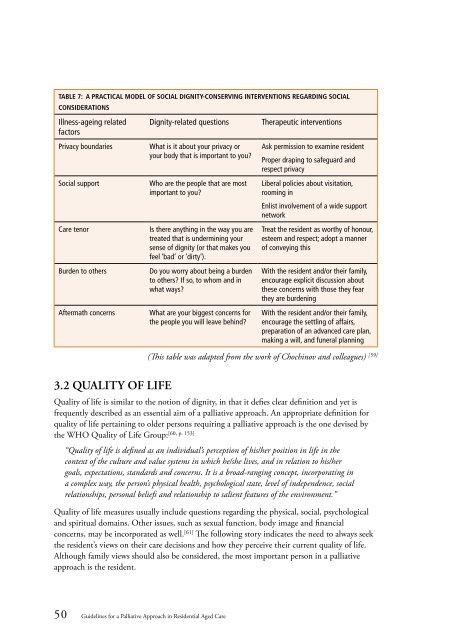Guidelines for a Palliative Approach in Residential Aged Care
Guidelines for a Palliative Approach in Residential Aged Care
Guidelines for a Palliative Approach in Residential Aged Care
Create successful ePaper yourself
Turn your PDF publications into a flip-book with our unique Google optimized e-Paper software.
Table 7: A practical model of social dignity-conserv<strong>in</strong>g <strong>in</strong>terventions regard<strong>in</strong>g social<br />
considerations<br />
Illness-age<strong>in</strong>g related<br />
factors<br />
Privacy boundaries<br />
Social support<br />
<strong>Care</strong> tenor<br />
Burden to others<br />
Aftermath concerns<br />
Dignity-related questions<br />
What is it about your privacy or<br />
your body that is important to you?<br />
Who are the people that are most<br />
important to you?<br />
Is there anyth<strong>in</strong>g <strong>in</strong> the way you are<br />
treated that is underm<strong>in</strong><strong>in</strong>g your<br />
sense of dignity (or that makes you<br />
feel ‘bad’ or ‘dirty’).<br />
Do you worry about be<strong>in</strong>g a burden<br />
to others? If so, to whom and <strong>in</strong><br />
what ways?<br />
What are your biggest concerns <strong>for</strong><br />
the people you will leave beh<strong>in</strong>d?<br />
Therapeutic <strong>in</strong>terventions<br />
Ask permission to exam<strong>in</strong>e resident<br />
Proper drap<strong>in</strong>g to safeguard and<br />
respect privacy<br />
Liberal policies about visitation,<br />
room<strong>in</strong>g <strong>in</strong><br />
Enlist <strong>in</strong>volvement of a wide support<br />
network<br />
Treat the resident as worthy of honour,<br />
esteem and respect; adopt a manner<br />
of convey<strong>in</strong>g this<br />
With the resident and/or their family,<br />
encourage explicit discussion about<br />
these concerns with those they fear<br />
they are burden<strong>in</strong>g<br />
With the resident and/or their family,<br />
encourage the settl<strong>in</strong>g of affairs,<br />
preparation of an advanced care plan,<br />
mak<strong>in</strong>g a will, and funeral plann<strong>in</strong>g<br />
(This table was adapted from the work of Choch<strong>in</strong>ov and colleagues) [59]<br />
3.2 QUALITY OF LIFE<br />
Quality of life is similar to the notion of dignity, <strong>in</strong> that it defies clear def<strong>in</strong>ition and yet is<br />
frequently described as an essential aim of a palliative approach. An appropriate def<strong>in</strong>ition <strong>for</strong><br />
quality of life perta<strong>in</strong><strong>in</strong>g to older persons requir<strong>in</strong>g a palliative approach is the one devised by<br />
the WHO Quality of Life Group:<br />
[60, p. 153]<br />
“Quality of life is def<strong>in</strong>ed as an <strong>in</strong>dividual’s perception of his/her position <strong>in</strong> life <strong>in</strong> the<br />
context of the culture and value systems <strong>in</strong> which he/she lives, and <strong>in</strong> relation to his/her<br />
goals, expectations, standards and concerns. It is a broad-rang<strong>in</strong>g concept, <strong>in</strong>corporat<strong>in</strong>g <strong>in</strong><br />
a complex way, the person’s physical health, psychological state, level of <strong>in</strong>dependence, social<br />
relationships, personal beliefs and relationship to salient features of the environment.”<br />
Quality of life measures usually <strong>in</strong>clude questions regard<strong>in</strong>g the physical, social, psychological<br />
and spiritual doma<strong>in</strong>s. Other issues, such as sexual function, body image and f<strong>in</strong>ancial<br />
concerns, may be <strong>in</strong>corporated as well. [61] The follow<strong>in</strong>g story <strong>in</strong>dicates the need to always seek<br />
the resident’s views on their care decisions and how they perceive their current quality of life.<br />
Although family views should also be considered, the most important person <strong>in</strong> a palliative<br />
approach is the resident.<br />
50 <strong>Guidel<strong>in</strong>es</strong> <strong>for</strong> a <strong>Palliative</strong> <strong>Approach</strong> <strong>in</strong> <strong>Residential</strong> <strong>Aged</strong> <strong>Care</strong>
















